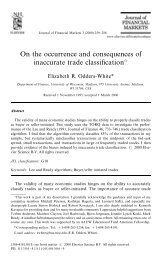A generic framework for Arabic to English machine ... - Acsu Buffalo
A generic framework for Arabic to English machine ... - Acsu Buffalo
A generic framework for Arabic to English machine ... - Acsu Buffalo
Create successful ePaper yourself
Turn your PDF publications into a flip-book with our unique Google optimized e-Paper software.
6.2. UNIARAB: LEXICAL REPRESENTATION IN INTERLINGUA SYSTEM BASED ON RRG<br />
in<strong>for</strong>mation about the tense of this verb.<br />
Figure 6.4: In<strong>for</strong>mation recorded on the <strong>Arabic</strong> verb<br />
Table 6.1: Verb 1<br />
<strong>Arabic</strong> verb qr֓a<br />
<strong>English</strong> translation read<br />
Logical structure [do’(x,[read’(x,(y)])]<br />
Tense past<br />
Gender m<br />
Person 3rd<br />
Number singular<br />
Table 6.2: Verb 2<br />
<strong>Arabic</strong> verb ktbt<br />
<strong>English</strong> translation wrote<br />
Logical structure [do’(x,[write’(x,(y)])]<br />
Tense past<br />
Gender f<br />
Person 3rd<br />
Number singular<br />
In the <strong>Arabic</strong> language, tense can be past or present as the primary distinction. Gender is<br />
an <strong>Arabic</strong> attribute of the verb. The verb agrees with the subject in gender. The Person<br />
attribute could be first, second or third person. The Number attribute refers <strong>to</strong> number of<br />
the subject. In <strong>Arabic</strong>, the number of a verb can be singular, dual or plural. Table 6.1<br />
and Table 6.2 shows an example of one <strong>Arabic</strong> verb applied <strong>to</strong> different genders. The<br />
absence of t ‘t’ suffix signifies m: gender. The <strong>English</strong> translation of these verbs are<br />
‘read’ and ‘wrote’.<br />
87
















